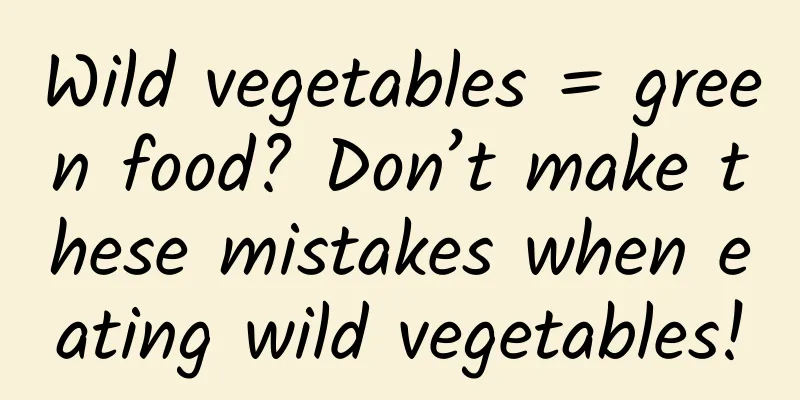Wild vegetables = green food? Don’t make these mistakes when eating wild vegetables!

|
The weather gradually warms up in March and April. As the temperature rises, various wild vegetables begin to grow slowly. Many elderly people also start to "grow grass" in their hearts, always thinking about going out to dig some wild vegetables to eat. After all, in many people's minds, wild vegetables are wild, which means they are green food and healthy. Is this really the case? There are many kinds of wild vegetables, and many of them may be "poisonous weeds". If you eat the wrong ones, it can be really "fatal". In this article, let's talk about wild vegetables. Image source: Copyright Library Are wild vegetables green foods? my country has clear regulations on green food, which is divided into two levels: AA and A. Grade A green food requires the use of limited amounts of chemical synthetic substances; while AA green food has more stringent requirements, and must not use any chemical synthetic fertilizers, pesticides, veterinary drugs, feed additives, food additives, or other substances that are harmful to the environment and human health during the production process, and must be produced in accordance with organic production methods. [1] In other words, green food pays more attention to "pollution-free" or "harmless" than general food, and has the dual advantages of nutrition and safety. Although wild vegetables grow naturally in nature, they are not considered green food. After all, there is no supervision on the quality and safety of wild vegetables. The soil, environment, and water sources where wild vegetables grow may have been polluted, and may even be contaminated with pesticides. A 2021 paper reported the risk assessment of heavy metal pollution in nine wild vegetables in Jilin Province. The nine vegetables were commonly eaten, namely Acanthopanax senticosus, Echinops edulis, Fern, Taraxacum officinale, Artemisia selengensis, Shepherd's purse, Sonchus endive, Celery, and Allium scabra. The results showed that the order of the degree of heavy metal pollution in five of the nine wild vegetables was Cd>Cr>Pb>As>Hg. Cd, Cr, and Pb were slightly polluted, while As and Hg were relatively safe. Compared with cultivated vegetables, wild vegetables pose a greater health risk to the human population. [2] There was also an experiment that tested the lead and cadmium content in 90 wild vegetable samples of water celery, amaranth, shepherd's purse, and water celery from eight regions in Zhejiang Province. The results found that the heavy metal lead content of the three wild vegetables exceeded the standard rate by 56.7%, with differences in different regions. [3] Excessive lead intake can damage the nervous system, hematopoietic system, and kidney health. Therefore, even natural wild vegetables are not necessarily green food, and eating them frequently may be harmful to your health. Don't eat these wild vegetables Wild vegetables can be found everywhere in spring, but you can't pick them blindly, because many wild vegetables look very similar to poisonous plants and are easy to confuse. If you eat poisonous wild vegetables by mistake, you will be in trouble. Don't eat the following poisonous wild vegetables! Wild celery: Wild celery is also called large-leaf celery. Incidents of poisoning due to accidental ingestion of wild celery often occur in Northeast my country. The toxic ingredients are coniine, methyl coniine and conitoxin. After consumption, people will suffer from arrhythmia, nausea, vomiting, blurred vision, numbness of the whole body, and even death. It mainly grows in humid places, its leaves are like celery leaves, it blooms in summer, and the whole plant is poisonous and accompanied by a foul smell. Image source: Copyright Library Lycoris: Lycoris’ roots look very similar to the garlic we usually eat. Garlic is safe and edible, but Lycoris cannot be eaten. Its bulbs contain a variety of alkaloids, including lycorine, pseudolycorine, and lycorine. Ingestion may cause poisoning, with mild cases causing vomiting and diarrhea, and severe cases causing central nervous system paralysis and life-threatening consequences. [4] Gelsemium elegans: Gelsemium elegans is also known as Gelsemium elegans, rotten intestine grass, bitter kiss, bitter medicine, anesthetic vine, pig ginseng, etc. Some people mistakenly eat it as honeysuckle. The entire plant of Gelsemium elegans is poisonous, with the highest toxin content in the root. The main component is colseline, of which colseline is the highest. Colseline is the most toxic and is a neurotoxin. Eating it can cause dizziness, severe pain in the throat and abdomen, foaming at the mouth, dilated pupils, muscle weakness, and jaw loss. In severe cases, it can lead to death from heart and respiratory failure. [5] Xanthium sibiricum: Raw Xanthium sibiricum has certain toxicity. After consumption, mild symptoms include local itching, redness and swelling, dizziness, nausea, vomiting, and coughing. In severe cases, it can cause damage to the digestive system, respiratory system, urinary system, and nervous system functions. Among them, liver and kidney damage is particularly serious and can lead to death. However, after processing, its toxicity can be reduced and it can become a traditional Chinese medicine. [6] Datura: The whole plant of Datura is poisonous, and the seeds are the most toxic. The toxic substances are hyoscyamine, scopolamine, and atropine. Overdose can cause clinical symptoms of atropine poisoning. It can cause auditory and visual hallucinations, convulsions, irritability, and in severe cases, it can inhibit the central nervous system, cause a drop in blood pressure, weakened breathing, and eventually respiratory failure and death. [7] Children who consume 3 to 8 seeds of Datura and adults who consume 3 to 30 seeds can be poisoned or even die. Poisonous lettuce: Poisonous lettuce is also called thorny lettuce. It is very similar to the lettuce we usually eat, but it has a row of sharp thorns on its back. It is an invasive and poisonous plant. This plant has a strong survival ability and can survive in environments such as roadsides, railways, farmlands, orchards, pastures, and sandy soils. The entire plant of lettuce is poisonous and contains anesthetic ingredients, especially when it blooms. The plant's latex contains a substance called "lettuce paste", which has a weak opium effect but does not cause digestive disorders or addiction. Ordinary doses can cause drowsiness, while excessive doses can cause anxiety. If taken in excessive amounts, it can cause heart failure and death. [8] The wild vegetables mentioned above are all "poisonous weeds" and should never be eaten. There are also some wild vegetables that can be eaten, but you must pay attention to the cooking method and the amount of consumption, otherwise it may also harm your health. Wild vegetables that need to be eaten with caution Bracken: Bracken is also called dragon head vegetable and Ruyi vegetable. It is green and tender, and is very popular in spring. Bracken is rich in minerals such as potassium and carotene. Unfortunately, studies have shown that bracken is carcinogenic and can cause tumors in multiple parts of many animals. In Japan and other countries, bracken has been found to be closely related to upper gastrointestinal cancer in humans. Eating bracken can increase the incidence of esophageal cancer and gastric cancer by 5.1 to 8.1 times. [9] This is a heavy blow to those who love to eat bracken. Can they still eat it? The main carcinogen in bracken is protopteroside, which is a Class 2A carcinogen, meaning it has been proven to cause cancer in animals, but there is limited evidence that it causes cancer in humans. Eating bracken is not 100% carcinogenic, but it will increase the risk of cancer. Image source: Copyright Library But there is also good news. Prototaxol is mainly concentrated in the head of the bracken, which is also sensitive to heat. After removing the head of fresh bracken, blanching it in water above 90°C for 30 seconds can reduce the content of prototaxol to zero. The bracken can also be pickled and eaten. Pickling it with a salt concentration of more than 5% for more than 3 days or fermenting it with lactic acid bacteria for 3 days or more can also greatly reduce the content of prototaxol, or even reduce it to zero. [9] Therefore, when eating bracken, you must blanch it in boiling water for more than 30 seconds, or you can pickle it before eating, so you don’t have to worry about cancer. Purslane: Purslane, also known as the longevity vegetable, is a common wild vegetable on the roadside with a very special taste. In terms of nutritional value, the carotene content of Purslane is relatively outstanding, at 2230 micrograms per 100 grams, and it contains oligosaccharides that can improve intestinal health. However, the oxalic acid content of purslane is particularly high. The oxalic acid content of spinach is 606 mg/100 g, while the oxalic acid content of purslane is as high as 1460 mg/100 g. [10] Ingesting a large amount of oxalic acid will form insoluble calcium oxalate crystals in the kidneys, blocking the renal tubules and causing acute kidney damage. There are also cases of acute renal failure after eating wild purslane in daily life. [11] If you want to eat purslane, you must blanch it first. Experiments have shown that if 100 grams of purslane is blanched in 500 ml of water for 3 minutes, the oxalic acid removal rate can reach more than 50%. After blanching for 4 minutes, discard the soup and eat it. The oxalic acid content is 560 mg/100 grams. Although this oxalic acid content is lower than that of fresh spinach, it is still higher than most green vegetables. It is better to eat less. Especially for people who already have kidney disease, it is best not to eat it. In addition to purslane, shepherd's purse and mugwort also contain oxalic acid, so it is best to blanch them before eating. Toona sinensis: Toona sinensis is a "vegetable that grows on trees". Scrambled eggs with toona sinensis, fried meat with toona sinensis, and toona sinensis sprouts mixed with tofu are all delicious dishes. However, the nitrite content of Chinese toon is not low. Studies have shown that the average nitrite content of Chinese toon after washing is 160.55 mg/kg. After being placed for 48 hours and blanched in 100°C boiling water for 30 seconds, the average nitrite content is 14.29 mg/kg. In addition, the nitrite content of Chinese toon stored for different storage times increases with the extension of storage time. The nitrite content of Chinese toon stored for 48 hours is 2.6 times that of that stored for less than 24 hours. [12] The nitrite content of common Chinese cabbage ranges from 0 to 11 mg/kg. [13] Excessive intake of nitrites can bring health risks. Nitrite reacts with protein decomposition products under acidic conditions to produce nitrosamines, which are recognized carcinogens. Therefore, Chinese toon must be blanched before eating. Image source: Copyright Library Summary: Be careful when eating wild vegetables in spring. Don't pick them up whenever you see them, and don't put all the vegetables in the basket. In addition, it is best not to eat wild vegetables from parks, community green belts, and fields, as they may be contaminated with pesticides. Be careful to prevent food poisoning after accidental ingestion. If you really want to eat this kind of food, it is recommended that you buy it from a regular supermarket, where you can feel more at ease eating it due to the quality control. References: [1] Sun Changhao. Nutrition and Food Hygiene. 8th edition. People's Medical Publishing House. 2018 [2] Zhang Zhendu, Zhang Qi, Zheng Yanjie, Meng Fanlei, Wang Jingyuan, Wei Chunyan. Risk assessment of heavy metal pollution in nine wild vegetables in Jilin Province[J]. Food Industry, 2021, 42(05): 480-484. [3] Shang Suwei, Wu Cuirong, Jiang Buyun, et al. Determination of heavy metal content in three wild vegetables in Zhejiang Province[J]. Jiangsu Agricultural Science, 2014, (4): 266-267. [4] Xiao Cheng. Commonly cultivated poisonous herbaceous plants in the south[J]. Flowers, 2017(15):15-19. [5] Wang Tingting, Li Xianwen, Ma Qinguo, Zhang Lu. Identification and analysis of the poisonous plant Gelsemium elegans[J]. Gansu Medicine, 2022, 41(01): 70-72. DOI: 10.15975/j.cnki.gsyy.2022.01.028. [6] Chen Ke, Fan Lili, Hou Chaofeng, Du Yijie, Meng Yiren, Meng Yong. Exploring the toxicity mechanism of Xanthium sibiricum based on network toxicology[J]. Bulletin of Traditional Chinese Medicine, 2022, 21(03): 33-38. DOI: 10.14046/j.cnki.zyytb2002.2022.03.007. [7] Wang Chu, Ma Qingmei, Chen Zongran. Rescue and nursing of acute Datura poisoning[J]. Chinese Journal of Practical Neurological Diseases, 2012, 15(8):89-91. [8] Zhou Yuling. Identification and control of invasive alien organisms - poisonous lettuce[J]. Xinjiang Agricultural Science and Technology, 2016(02):35-36. [9] Chen Qiong, Di Dianqi, Jiang Bianling, Feng Fan. Effects of different processing methods on carcinogens such as pteridin in bracken[J]. Journal of Chifeng University (Natural Science Edition), 2021, 37(11): 23-25. DOI: 10.13398/j.cnki.issn1673-260x.2021.11.007. [10] Zhou Sannu, Liu Liqing, Wu Xianhui, Tian Yanji, Pan Bin. Differences in oxalic acid content in fresh, boiled and harvested purslane[J]. Agricultural Products Processing, 2016(23):52-54.DOI:10.16693/j.cnki.1671-9646(X).2016.12.014. [11] Zheng Tengye, Chen Tianxin, Cai Luxi, Huang Zhaoxing. Report of two cases of acute renal failure after eating wild purslane[J]. Chinese Journal of Integrated Traditional and Western Medicine Nephrology, 2021, 22(10): 930-931+944. [12]. Zhang Binyan, Wang Yanzeng, Qin Zhiyi. Study on reducing the nitrite content of edible Toona sinensis[J]. Chinese Journal of Preventive Medicine, 1999, 33(004):254. [13]. Lu Qilin1, Wang Na2, Feng Xuqiao1,2,*, Zhao Hongxia2, Huang Xiaojie2,3. Analysis on the changes of nitrate and nitrite contents in Chinese cabbage during storage[J]. Food Science, doi: 10.7506/spkx1002-6630-201418030. Author: Xue Qingxin, registered nutritionist Review | Zhong Kai, Director of Kexin Food and Health Information Exchange Center The article is produced by "Science Refutes Facts" (ID: Science_Facts). Please indicate the source when reprinting. The pictures in this article are from the copyright gallery and are not authorized for reproduction. |
<<: What is responsible release?
>>: Which of the weird courtship behaviors in the animal world breaks your imagination?
Recommend
Is Apple making another big move? Thousands of apps removed from shelves at the same time? !
In the afternoon, one WeChat message and one phon...
Can you wear your watch while swimming? It all depends on the protection level
Can IP68 mobile phones really be used in any envi...
New version of Microsoft Launcher released: improved UI and battery life
Microsoft Launcher 6.2.201202.9334 for Android wa...
Contact list for offline channels for app promotion
D.Phone : : : : : : : : : : : : : : :...
E-commerce repurchase rate analysis and improvement strategies!
New users and repeat purchases are the two main s...
Android 13 will allow users to connect to two operators on one eSIM card
For those who are tired of switching carriers on ...
The Lantern Festival is coming, how to write copy that takes advantage of the situation?
It’s the Lantern Festival again. Have you thought...
E-commerce operation: How can merchants make good arrangements for the Double 12 promotion nodes?
I believe that many small and medium-sized seller...
Using technology to experience "X-ray vision"? Mothers no longer have to worry about not finding blood vessels when inserting needles?
What is the difference between humans and jellyfi...
How to tap into high-value customers through different channels?
Before their first contact with a salesperson, co...
China Automobile Dealers Association: Automobile consumption index in July 2022 is 81.6
On August 1, 2022, the China Automobile Dealers A...
There is a poison called "seven aunts and eight aunts", let's see how major brands can help you detoxify
As the year draws to a close, in addition to the ...
Is it difficult to convert users into promotion? Catering to the fun point is the key
With the development of information flow advertis...
Classic APP case: How did Taobao Tmall App create the Double 11 traffic-generating banner with hundreds of millions of traffic?
Every year when the annual big promotion season c...









